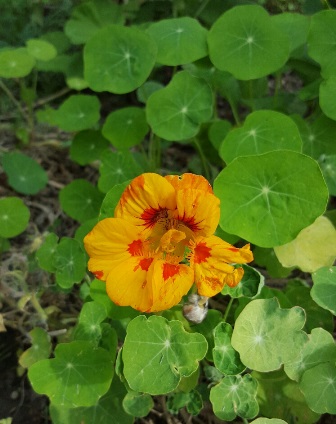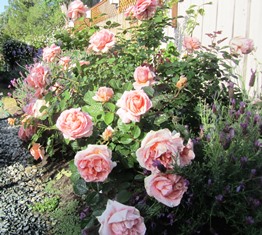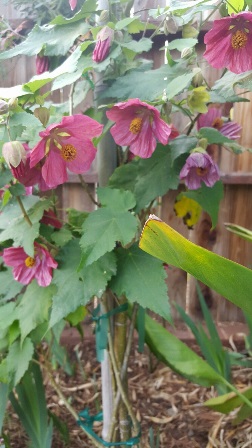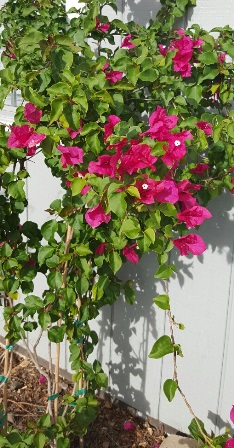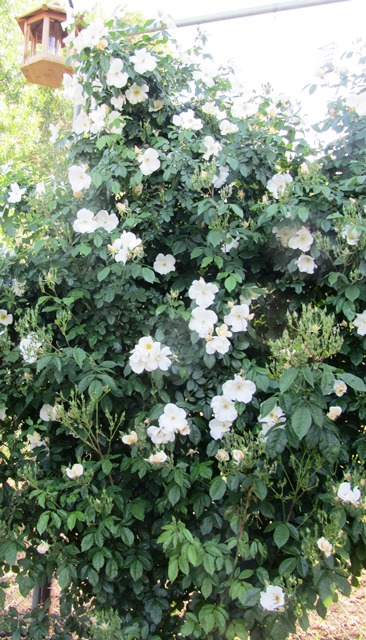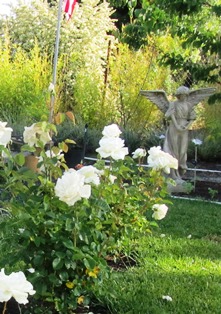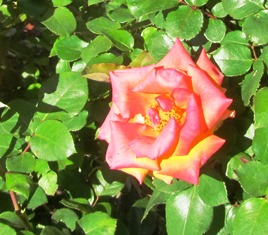A Rose Bush for Your Valentine?
If your sweetheart is a gardener, why not give a gift that keeps on giving? Instead of a single rose or a bouquet, consider giving a bare-root rose bush. A plethora of plants are arriving in garden centers now.
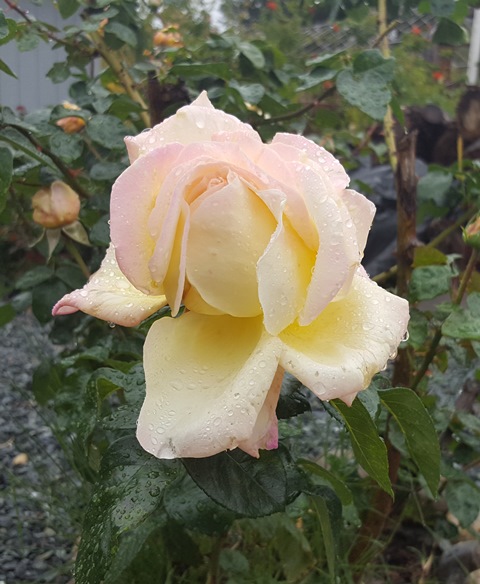
Many modern roses have been bred to bloom repeatedly throughout spring, summer, and fall, even into December in milder climates. With gorgeous single buds on tall stems or dazzling sprays of blooms, roses are the perfect cut flowers for indoor bouquets.
With the traditional “lover’s” day just around the corner, now is the time to decide on what type of rose bush to give your valentine. Bare-root season is the best time to purchase rose bushes. In a couple of months prices go up as unsold roses are re-potted in containers of soil with nutrients.
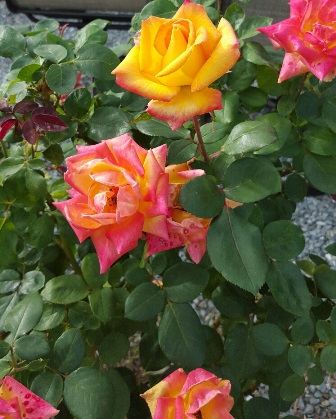
well-known “Ketchup & Mustard” floribunda
At the most basic level, roses are classified into three main categories: wild roses, old garden roses bred before 1867, and new roses bred or hybridized for modern gardens for fragrance, bloom size, color, and other desirable characteristics.

Before you buy, consider what characteristics you would like in a rose and choose a type that matches your purpose.
Modern varieties have been cultivated to produce roses to repeat bloom, bloom as single buds, or bloom in sprays. Some are fragrance-free; others offer a heady scent. Many roses have prickles (sometimes called thorns although technically they are not). The blooms of roses vary in size, shape, and number of petals as well as color. Some have a single color. Others display two or more colors as the blooms open and age.
Consider how much space your sweetie might have in his or her garden for growing the rose. Climbers need support like a wall, fence, or a trellis. Certain roses aren’t fussy about soil, other cultivars have specific needs. Be informed before you buy. Be sure to read the rose label for information about the cultivar.
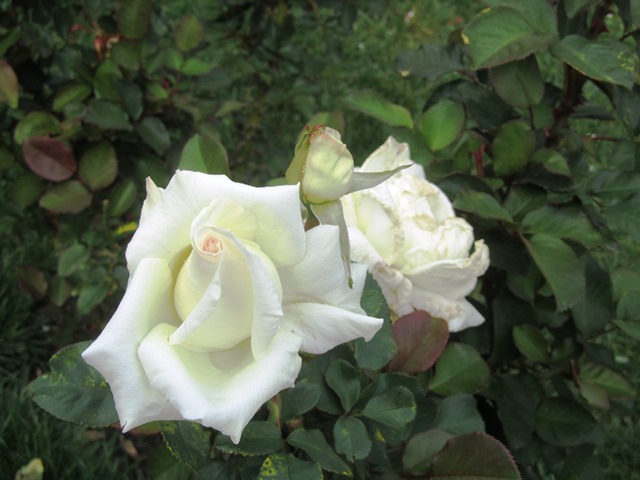
If you enjoy reading about gardening and country living and also love a good story, check out my Henny Penny Farmette series of cozy mysteries. All are available online and wherever books are sold. They include, A BEELINE TO MURDER, THE MURDER OF A QUEEN BEE, and A HIVE OF HOMICIDES.
Seasonal Blooms for Floral Arrangements
Autumn in Northern California is one of my favorite times of the year. By November, many of the summer blooms in our flower beds have faded. Seeds have been collected for next year’s blooms. Now’s the time to put in bulbs and tubers for spring, but that doesn’t mean we have no blooms for a Thanksgiving floral arrangement.
The clocks have been turned back and the rainy season has arrived, but don’t tell that to the roses.
Red-gold roses, pyracantha berries, rustic seed pods, orange- and rust-colored zinnias, asters, willowleaf cotoneaster, and dahlias are some of the garden plants that combine beautifully in a fall floral arrangement. To the harvest table, I also like to add some seasonal fruits like pomegranates and persimmons.
Thanks to the recent rain, the bougainvillea blazes in shades of fuchsia, orange, red, and purple. Zinnia’s near the farmette’s bee house are still holding color and hanging on until cold weather arrives.
And while pyracantha (fire thorn) berries add splashes of bright orange to a dark corner of the garden where bamboo towers to ten feet, the Chinese lantern plant holds aloft dozens of small pink blooms like little lanterns.
With Thanksgiving three weeks away, I’m feeling confident that our table arrangement will include some of the season’s festive berries, seed pods, and blooming flowers collected from around the farmette.
In the meantime, I’ll notice the splashes of color to be discovered here and there and consider how to use them in a holiday bouquet.
* * *
NEWLY RELEASED–The Murder of a Queen Bee (Kensington Publishing, NY–Sept. 2016).
Discover delicious farm-to-table recipes, farming tips, and wisdom as well as sort out a charming whodunnit. Also, enjoy gardening tips and farm sayings. Dig for clues while learning about bees and chickens. To learn more, click on the link under the picture.
See, http://tinyurl.com/h4kou4g
See, http://tinyurl.com/hxy3s8q
This debut novel launched the Henny Penny Farmette series of mysteries and sold out its first press run. It’s now available in mass market paperback and other formats.
Propagating Plants from Rose Cuttings
Roses are among the most romantic flowers in a garden. I grow dozens of cultivars of rose bushes–climbers, hybrid teas, floribundas, and polyanthas. When I have an extra few dollars, I might spend it on a rose bush, but when money is tight, I simply start a new bush from one of my favorites that I’m currently growing.
My husband and I love the climbers. We have tall fences (over six feet) around our property on all sides. Covering an entire fence is easy when you use a vigorous, virtually pest-free climber. Two roses that quickly adapt and grow to fantastic heights are Sally Holmes and Cecile Brunner.
Climbing roses need strong support, since some canes can reach forty feet or more as they scramble over a roof or stone wall, trellis, fence, or arbor.
Last year, my husband created a rose arbor on wires strung from the fence along the north side of our house to the roof line. He planted the Cecile Brunner rose as his climber of choice. Its sage green leaves make a lovely foil for the tiny pink roses that permeate the air with a spicy-sweet scent throughout the spring. Cutting and feeding will render another bloom in summer.
My garden has plenty of places where I could tuck in a new rose bush, and I’ve bought many over the years. I have some favorites that I’d like to start in other areas. They include A Shropshire Lad, Handel, Lady Banks (a thornless yellow rose), and Iceberg.
This is the perfect time to propagate roses from cuttings in the Bay Area since the rose bushes in many yards are beginning to awaken. Roses require water, something no longer plentiful in California. Thanks to a severe four-year drought, we now have mandatory water restrictions. That means we gardeners must consider how we can recycle water, use gray water, collect water, and otherwise find ways to reduce water usage.
To propagate a rose from your favorite bush, take a six-inch cutting from a healthy cane. Make the bottom cut a sharp angle cut, not straight across. Do not crush the stem. Remove the leaves.
Dip the angle cut into a jar of root hormone powder. This powder enables the cane to root more easily in the ground or pot.
Insert the prepared cutting in the soil. Water as needed when the soil is dry. The cutting will need one to two months to root and then, it will begin to leaf out.
Some people like to put a quart jar over their cutting to create a mini-green house climate. In mild climates like the Bay Area, this isn’t necessary. The best time to propagate cuttings from your favorite roses is in the spring and never in extremes of cold or heat.
Creating romance in the garden could start with a table and chairs, floral-motif linens, and a service of tea. But even before those accoutrements to romance are added, why not fill the space with roses? It’s so easy.
Speaking of Roses
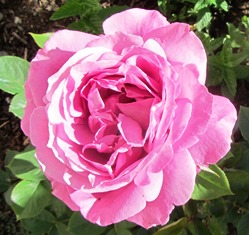
This candy-stripe rose was a gift from a friend–a cutting from her rose that became a large bush in my garden
If you love roses like I do, you probably already have a few growing in your garden. Perhaps you also look forward during long winter evenings to perusing the offerings in the catalogs of rose growers and dreaming of new varieties to plant in the spring.
Whether you are new to growing roses or have been gardening with them for a while, a review of types and species might be in order, especially before you plan a visit to your local gardening center. Bare root roses will start arriving in about three weeks here in Northern California.
TYPES OF ROSES
Roses fall roughly into four general categories: Bush Roses (this is the largest group and includes hybrid tea, polyantha, floribunda, heritage or old rose, miniature, and tree roses), Climbing Roses (large-flowering climbers have canes to 10 feet, ramblers have canes to 20+ feet and small flowers in early summer), Shrub Roses (upright growth habit reaches 4 to 12 feet and may only bloom once during summer), Groundcover Roses (also called carpet roses, these grown in low mounds and can bloom only once or repeatedly).
SPECIES of ROSES
Alba–These beauties are white or palest pink with gray-green foliage.
Bourbon–Repeat bloomers that have a wide height range and glossy green foliage.
Centifolia–These stunning beauties were favored by the Dutch master painters. Centifolia roses contain many petals on cold-hardy plants that grow 4 to 8 feet tall.
Climbers–These roses come in a wide variety of bloom type and color and have long, arching canes.
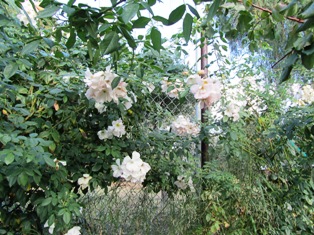
Climbing Sally Holmes produces large sprays of white to palest pink roses along the back fence of our property, from early spring to frost
Damask–May bloom only once although some varieties will repeat; the flowers are white or soft pink and fragrant. For centuries, this was the rose species used to produce Attar of Roses.
Florabunda–Produces sprays of roses and is a repeat bloomer.
Grandiflora–Similar to hybrid tea roses, the grandiflora blooms on long canes and is associated with the high-centered blooms so often seen in floral shops.
Hybrid Gallica–An old rose that blooms in the spring; flowers are pink or red or even striped and emerge on plants that stand about 4 feet tall.
Hybrid Perpetual–These roses were especially loved in the 1800’s for their red and pink color, repeat flowering, and height of six feet.
Hybrid Tea–Blooms on long canes as a single bloom or sprays of flowers.
Polyantha–Smaller blooms than the florabundas but can produce large sprays in repeated flowering.
Noisette–Plants tend to be large and often sprawl but can produce fragrant clusters of blooms and are repeat-flowering. They are sensitive to cold and frost.
Miniature–Small roses ranging in height from 1 to 3 feet with miniature flowers and foliage.
Shrub–Hybrid rugosas are an example of the shrub varieties (of which there are many). Often these roses have lots of prickles.
Tea Roses–These plants have quite large blooms, but the drawbacks include weak canes and a susceptibility to frost and cold. Their height and bloom color can vary widely.
 Facebook
Facebook Goodreads
Goodreads LinkedIn
LinkedIn Meera Lester
Meera Lester Twitter
Twitter





